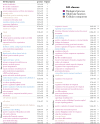Genomic Diversity Illuminates the Environmental Adaptation of Drosophila suzukii
- PMID: 39235033
- PMCID: PMC11421661
- DOI: 10.1093/gbe/evae195
Genomic Diversity Illuminates the Environmental Adaptation of Drosophila suzukii
Abstract
Biological invasions carry substantial practical and scientific importance and represent natural evolutionary experiments on contemporary timescales. Here, we investigated genomic diversity and environmental adaptation of the crop pest Drosophila suzukii using whole-genome sequencing data and environmental metadata for 29 population samples from its native and invasive range. Through a multifaceted analysis of this population genomic data, we increase our understanding of the D. suzukii genome, its diversity and its evolution, and we identify an appropriate genotype-environment association pipeline for our dataset. Using this approach, we detect genetic signals of local adaptation associated with nine distinct environmental factors related to altitude, wind speed, precipitation, temperature, and human land use. We uncover unique functional signatures for each environmental variable, such as the prevalence of cuticular genes associated with annual precipitation. We also infer biological commonalities in the adaptation to diverse selective pressures, particularly in terms of the apparent contribution of nervous system evolution to enriched processes (ranging from neuron development to circadian behavior) and to top genes associated with all nine environmental variables. Our findings therefore depict a finer-scale adaptive landscape underlying the rapid invasion success of this agronomically important species.
Keywords: Drosophila suzukii; environmental adaptation; genotype–environment association; invasion genomics.
© The Author(s) 2024. Published by Oxford University Press on behalf of Society for Molecular Biology and Evolution.
Conflict of interest statement
Conflict of Interest The authors have no conflicts of interest to declare.
Figures





Update of
-
Genomic Diversity Illuminates the Environmental Adaptation of Drosophila suzukii.bioRxiv [Preprint]. 2023 Oct 19:2023.07.03.547576. doi: 10.1101/2023.07.03.547576. bioRxiv. 2023. Update in: Genome Biol Evol. 2024 Sep 3;16(9):evae195. doi: 10.1093/gbe/evae195. PMID: 37461625 Free PMC article. Updated. Preprint.
References
-
- Asplen MK, Anfora G, Biondi A, Choi D-S, Chu D, Daane KM, Gibert P, Gutierrez AP, Hoelmer KA, Hutchison WD, et al. . Invasion biology of spotted wing Drosophila (Drosophila suzukii): a global perspective and future priorities. J Pest Sci. 2015:88(3):469–494. 10.1007/s10340-015-0681-z. - DOI
MeSH terms
Grants and funding
LinkOut - more resources
Full Text Sources
Molecular Biology Databases

